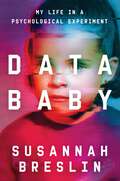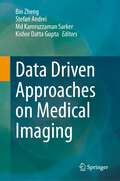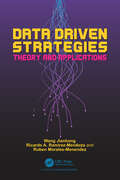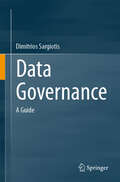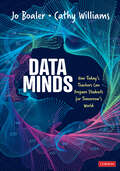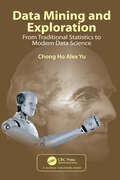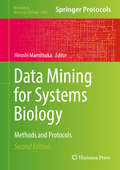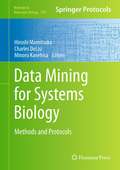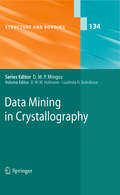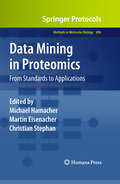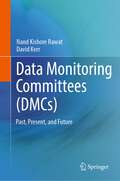- Table View
- List View
Data Baby: My Life in a Psychological Experiment
by Susannah BreslinA Belletrist Book Pick for December 2023Lab Girl meets Brain on Fire in this provocative and poignant memoir delving into a woman's formative experiences as a veritable "lab rat" in a lifelong psychological study, and her pursuit to reclaim autonomy and her identity as a adult. What if your parents turn you into a human lab rat when you&’re a child? Will that change the story of your life? Will that change who you are? When Susannah Breslin is a toddler, her parents enroll her in an exclusive laboratory preschool at the University of California, Berkeley, where she becomes one of over a hundred children who are research subjects in an unprecedented thirty-year study of personality development that predicts who she and her cohort will grow up to be. Decades later, trapped in what she feels is an abusive marriage and battling breast cancer, she starts to wonder how growing up under a microscope shaped her identity and life choices. Already a successful journalist, she makes her own curious history the subject of her next investigation. From experiment rooms with one-way mirrors, to children&’s puzzles with no solutions, to condemned basement laboratories, her life-changing journey uncovers the long-buried secrets hidden behind the renowned study. The question at the gnarled heart of her quest: Did the study know her better than she knew herself? At once bravely honest and sharply witty, Data Baby is a compelling and provocative account of a woman&’s quest to find her true self, and an unblinking exploration of why we turn out as we do. Few people in all of history have been studied from such a young age and for as long as this author, but the message of her book is universal. In an era when so many of us are looking to technology to tell us who to be, it&’s up to us to discover who we actually are.
Data Cartels: The Companies That Control and Monopolize Our Information
by Sarah LamdanIn our digital world, data is power. Information hoarding businesses reign supreme, using intimidation, aggression, and force to maintain influence and control. Sarah Lamdan brings us into the unregulated underworld of these "data cartels", demonstrating how the entities mining, commodifying, and selling our data and informational resources perpetuate social inequalities and threaten the democratic sharing of knowledge. Just a few companies dominate most of our critical informational resources. Often self-identifying as "data analytics" or "business solutions" operations, they supply the digital lifeblood that flows through the circulatory system of the internet. With their control over data, they can prevent the free flow of information, masterfully exploiting outdated information and privacy laws and curating online information in a way that amplifies digital racism and targets marginalized communities. They can also distribute private information to predatory entities. Alarmingly, everything they're doing is perfectly legal. In this book, Lamdan contends that privatization and tech exceptionalism have prevented us from creating effective legal regulation. This in turn has allowed oversized information oligopolies to coalesce. In addition to specific legal and market-based solutions, Lamdan calls for treating information like a public good and creating digital infrastructure that supports our democratic ideals.
Data Driven Approaches on Medical Imaging
by Bin Zheng Stefan Andrei Md Kamruzzaman Sarker Kishor Datta GuptaThis book deals with the recent advancements in computer vision techniques such as active learning, few-shot learning, zero shot learning, explainable and interpretable ML, online learning, AutoML etc. and their applications in medical domain. Moreover, the key challenges which affect the design, development, and performance of medical imaging systems are addressed. In addition, the state-of-the-art medical imaging methodologies for efficient, interpretable, explainable, and practical implementation of computer imaging techniques are discussed. At present, there are no textbook resources that address the medical imaging technologies. There are ongoing and novel research outcomes which would be useful for the development of novel medical imaging technologies/processes/equipment which can improve the current state of the art.The book particularly focuses on the use of data driven new technologies on medical imaging vision such as Active learning, Online learning, few shot learning, AutoML, segmentation etc.
Data Driven Energy Centered Maintenance (Energy Management)
by Marvin T. Howell Fadi AlshakhshirOver recent years, many new technologies have been introduced to drive the digital transformation in the building maintenance industry. The current trend in digital evolution involves data-driven decision making which opens new opportunities for an energy centered maintenance model. Artificial Intelligence and Machine Learning are helping the maintenance team to get to the next level of maintenance intelligence to provide real-time early warning of abnormal equipment performance. This edition follows the same methodology as the First. It provides detailed descriptions of the latest technologies associated with Artificial Intelligence and Machine Learning which enable data-driven decision-making processes about the equipment’s operation and maintenance. Technical topics discussed in the book include: Different Maintenance Types and The Need for Energy Centered Maintenance The Centered Maintenance Model Energy Centered Maintenance Process Measures of Equipment and Maintenance Efficiency and Effectiveness Data-Driven Energy Centered Maintenance Model: Digitally Enabled Energy Centered Maintenance Tasks Artificial Intelligence and Machine Learning in Energy Centered Maintenance Model Capabilities and Analytics Rules Building Management System Schematics The book contains a detailed description of the digital transformation process of most of the maintenance inspection tasks as they move away from being manually triggered. The book is aimed at building operators as well as those building automation companies who are working continuously to digitalize building operation and maintenance procedures. The benefits are reductions in the equipment failure rate, improvements in equipment reliability, increases in equipment efficiency and extended equipment lifespan.
Data Driven Guide to the Analysis of X-ray Photoelectron Spectra using RxpsG
by Giorgio SperanzaThis book provides a theoretical background to X-ray photoelectron spectroscopy (XPS) and a practical guide to the analysis of the XPS spectra using the RxpsG software, a powerful tool for XPS analysis. Although there are several publications and books illustrating the theory behind XPS and the origin of the spectral feature, this book provides an additional practical introduction to the use of RxpsG. It illustrates how to use the RxpsG software to perform specific key operations, with figures and examples which readers can reproduce themselves. The book contains a list of theoretical sections explaining the appearance of the various spectral features (core‑lines, Auger components, valence bands, loss features, etc.). They are accompanied by practical steps, so readers can learn how to analyze specific spectral features using the various functions of the RxpsG software. This book is a useful guide for researchers in physics, chemistry, and material science who are looking to begin using XPS, in addition to experienced researchers who want to learn how to use RxpsG. In the digital format, the spectral data and step-by-step indications are provided to reproduce the examples given in the textbook. RxpsG is a free software for the spectral analysis. Readers can find the installation information and download the package from https://github.com/GSperanza/ website. RxpsG was developed mainly by Giorgio Speranza with the help of his colleague dr. Roberto Canteri working at Fondazione Bruno Kessler. Key Features: Simplifies the use of RxpsG, how it works, and its applications. Demonstrates RxpsG using a reproduction of the graphical interface of RxpsG, showing the steps needed to perform a specific task and the effect on the XPS spectra. Accessible to readers without any prior experience using the RxpsG software. Giorgio Speranza is Senior Researcher at Fondazione Bruno Kessler – Trento Italy, Associate Member of the Italian National Council of Research, and Associate Member of the Department of Industrial Engineering at the University of Trento, Italy.
Data Driven Mathematical Modeling in Agriculture: Tools and Technologies (River Publishers Series in Mathematical, Statistical and Computational Modelling for Engineering)
by Sandip Roy Sabyasachi Pramanik Rajesh BoseThe research in this book looks at the likelihood and level of use of implemented technological components with regard to the adoption of different precision agricultural technologies. To identify the variables affecting farmers' choices to embrace more precise technology, zero-inflated Poisson and negative binomial count data regression models are utilized. Outcomes from the count data analysis of a random sample of various farm operators show that various aspects, including farm dimension, farmer demographics, soil texture, urban impacts, farmer position of liabilities, and position of the farm in a state, were significantly associated with the approval severity and likelihood of precision farming technologies.Technical topics discussed in the book include: Precision agriculture Machine learning Wireless sensor networks IoT Deep learning
Data Driven Strategies: Theory and Applications
by Ricardo A. Ramirez-Mendoza Ruben Morales-Menendez Wang JianhongA key challenge in science and engineering is to provide a quantitative description of the systems under investigation, leveraging the noisy data collected. Such a description may be a complete mathematical model or a mechanism to return controllers corresponding to new, unseen inputs. Recent advances in the theories are described in detail, along with their applications in engineering. The book aims to develop model-free system analysis and control strategies, i.e., data-driven control from theoretical analysis and engineering applications based only on measured data. The study aims to develop system identification, and combination in advanced control theory, i.e., data-driven control strategy as system and controller are generated from measured data directly. The book reviews the development of system identification and its combination in advanced control theory, i.e., data-driven control strategy, as they all depend on measured data. Firstly, data-driven identification is developed for the closed-loop, nonlinear system and model validation, i.e., obtaining model descriptions from measured data. Secondly, the data-driven idea is combined with some control strategies to be considered data-driven control strategies, such as data-driven model predictive control, data-driven iterative tuning control, and data-driven subspace predictive control. Thirdly data-driven identification and data-driven control strategies are applied to interested engineering. In this context, the book provides algorithms to perform state estimation of dynamical systems from noisy data and some convex optimization algorithms through identification and control problems.
Data Governance: A Guide
by Dimitrios SargiotisThis book is a comprehensive resource designed to demystify the complex world of data governance for professionals across various sectors. This guide provides in-depth insights, methodologies, and best practices to help organizations manage their data effectively and securely. It covers essential topics such as data quality, privacy, security, and management ensuring that readers gain a holistic understanding of how to establish and maintain a robust data governance framework. Through a blend of theoretical knowledge and practical applications, this book addresses the challenges and benefits of data governance, equipping readers with the tools needed to navigate the evolving data landscape. In addition to foundational principles, this book explores real-world case studies that illustrate the tangible benefits and common pitfalls of implementing data governance. Emerging trends and technologies, including artificial intelligence, machine learning, and blockchain are also examined to prepare readers for future developments in the field. Whether you are a seasoned data management professional or new to the discipline, this book serves as an invaluable resource for mastering the intricacies of data governance and leveraging data as a strategic asset for organizational success. This resourceful guide targets data management professionals, IT managers, Compliance officers, Data Stewards, Data Owners Data Governance Managers and more. Business leaders, business executives academic researchers, students focused on computer science in data-related fields will also find this book a useful resource.
Data Journeys in the Sciences
by Sabina Leonelli Niccolò TempiniThis groundbreaking, open access volume analyses and compares data practices across several fields through the analysis of specific cases of data journeys. It brings together leading scholars in the philosophy, history and social studies of science to achieve two goals: tracking the travel of data across different spaces, times and domains of research practice; and documenting how such journeys affect the use of data as evidence and the knowledge being produced. The volume captures the opportunities, challenges and concerns involved in making data move from the sites in which they are originally produced to sites where they can be integrated with other data, analysed and re-used for a variety of purposes. The in-depth study of data journeys provides the necessary ground to examine disciplinary, geographical and historical differences and similarities in data management, processing and interpretation, thus identifying the key conditions of possibility for the widespread data sharing associated with Big and Open Data. The chapters are ordered in sections that broadly correspond to different stages of the journeys of data, from their generation to the legitimisation of their use for specific purposes. Additionally, the preface to the volume provides a variety of alternative “roadmaps” aimed to serve the different interests and entry points of readers; and the introduction provides a substantive overview of what data journeys can teach about the methods and epistemology of research.
Data Minds: How Today’s Teachers Can Prepare Students for Tomorrow’s World
by Cathy Williams Jo BoalerDevelop curious minds. Empower every learner. Shape the future. How can we prepare students for a world where data-driven decision-making shapes nearly every aspect of life? Data Minds: How Today’s Teachers Can Prepare Students for Tomorrow’s World helps K–8 educators infuse data literacy into everyday lessons across disciplines, without overwhelming existing curricula. Data literacy is an ability and willingness to engage with and understand data in the world, and it can be incorporated throughout the school day to encourage student agency. Legendary educators Jo Boaler and Cathy Williams inspire teachers to develop "data minds" in their students—fostering analytical, creative, and skeptical thinkers who can successfully navigate the data-rich world. Aligned with current math, STEM, and GAISE II standards, this book Provides innovative, real-world stories from classrooms across the globe, offering inspiration and insight from other educators Highlights five key habits of mind that position students actively, giving them a role in seeking and investigating knowledge deeply Includes engaging and fascinating examples of data visualizations that demonstrate that data analysis goes way beyond charts and strings of numbers Offers flexible frameworks, including the Four-Part Data Cycle, that focus on asking questions, analyzing patterns, and developing multi-modal representations like graphs, maps, and even art pieces Presents extensive teacher "data moves," reflection questions, and examples in each chapter showing how to connect lessons to students’ interests, from oceanography to basketball Includes online access to free professional development resources and accompanying lessons through Stanford University’s youcubed From forming data questions to cultivating creativity, Data Minds will help educators turn every lesson into an opportunity for meaningful discovery. By integrating data literacy into the curriculum, teachers can unlock new levels of student engagement at the same time they are preparing learners for the demands of tomorrow′s workforce.
Data Minds: How Today’s Teachers Can Prepare Students for Tomorrow’s World
by Cathy Williams Jo BoalerDevelop curious minds. Empower every learner. Shape the future. How can we prepare students for a world where data-driven decision-making shapes nearly every aspect of life? Data Minds: How Today’s Teachers Can Prepare Students for Tomorrow’s World helps K–8 educators infuse data literacy into everyday lessons across disciplines, without overwhelming existing curricula. Data literacy is an ability and willingness to engage with and understand data in the world, and it can be incorporated throughout the school day to encourage student agency. Legendary educators Jo Boaler and Cathy Williams inspire teachers to develop "data minds" in their students—fostering analytical, creative, and skeptical thinkers who can successfully navigate the data-rich world. Aligned with current math, STEM, and GAISE II standards, this book Provides innovative, real-world stories from classrooms across the globe, offering inspiration and insight from other educators Highlights five key habits of mind that position students actively, giving them a role in seeking and investigating knowledge deeply Includes engaging and fascinating examples of data visualizations that demonstrate that data analysis goes way beyond charts and strings of numbers Offers flexible frameworks, including the Four-Part Data Cycle, that focus on asking questions, analyzing patterns, and developing multi-modal representations like graphs, maps, and even art pieces Presents extensive teacher "data moves," reflection questions, and examples in each chapter showing how to connect lessons to students’ interests, from oceanography to basketball Includes online access to free professional development resources and accompanying lessons through Stanford University’s youcubed From forming data questions to cultivating creativity, Data Minds will help educators turn every lesson into an opportunity for meaningful discovery. By integrating data literacy into the curriculum, teachers can unlock new levels of student engagement at the same time they are preparing learners for the demands of tomorrow′s workforce.
Data Mining Techniques for the Life Sciences (Methods in Molecular Biology #1415)
by Oliviero Carugo Frank EisenhaberWhereas getting exact data about living systems and sophisticated experimental procedures have primarily absorbed the minds of researchers previously, the development of high-throughput technologies has caused the weight to increasingly shift to the problem of interpreting accumulated data in terms of biological function and biomolecular mechanisms. In "Data Mining Techniques for the Life Sciences", experts in the field contribute valuable information about the sources of information and the techniques used for "mining" new insights out of databases. Beginning with a section covering the concepts and structures of important groups of databases for biomolecular mechanism research, the book then continues with sections on formal methods for analyzing biomolecular data and reviews of concepts for analyzing biomolecular sequence data in context with other experimental results that can be mapped onto genomes. As a volume of the highly successful Methods in Molecular BiologyTM series, this work provides the kind of detailed description and implementation advice that is crucial for getting optimal results. Authoritative and easy to reference, "Data Mining Techniques for the Life Sciences" seeks to aid students and researchers in the life sciences who wish to get a condensed introduction into the vital world of biological databases and their many applications.
Data Mining Techniques for the Life Sciences (Methods in Molecular Biology #2449)
by Oliviero Carugo Frank EisenhaberThis third edition details new and updated methods and protocols on important databases and data mining tools. Chapters guides readers through archives of macromolecular sequences and three-dimensional structures, databases of protein-protein interactions, methods for prediction conformational disorder, mutant thermodynamic stability, aggregation, and drug response. Quality of structural data and their release, soft mechanics applications in biology, and protein flexibility are considered, too, together with pan-genome analyses, rational drug combination screening and Omics Deep Mining. Written in the format of the highly successful Methods in Molecular Biology series, each chapter includes an introduction to the topic, lists necessary materials, includes step-by-step, readily reproducible protocols. Authoritative and cutting-edge, Data Mining Techniques for the Life Sciences, Third Edition aims to be a practical guide to researches to help further their study in this field.
Data Mining and Exploration: From Traditional Statistics to Modern Data Science
by Chong Ho Alex YuThis book introduces both conceptual and procedural aspects of cutting-edge data science methods, such as dynamic data visualization, artificial neural networks, ensemble methods, and text mining. There are at least two unique elements that can set the book apart from its rivals. First, most students in social sciences, engineering, and business took at least one class in introductory statistics before learning data science. However, usually these courses do not discuss the similarities and differences between traditional statistics and modern data science; as a result learners are disoriented by this seemingly drastic paradigm shift. In reaction, some traditionalists reject data science altogether while some beginning data analysts employ data mining tools as a “black box”, without a comprehensive view of the foundational differences between traditional and modern methods (e.g., dichotomous thinking vs. pattern recognition, confirmation vs. exploration, single method vs. triangulation, single sample vs. cross-validation etc.). This book delineates the transition between classical methods and data science (e.g. from p value to Log Worth, from resampling to ensemble methods, from content analysis to text mining etc.). Second, this book aims to widen the learner's horizon by covering a plethora of software tools. When a technician has a hammer, every problem seems to be a nail. By the same token, many textbooks focus on a single software package only, and consequently the learner tends to fit the problem with the tool, but not the other way around. To rectify the situation, a competent analyst should be equipped with a tool set, rather than a single tool. For example, when the analyst works with crucial data in a highly regulated industry, such as pharmaceutical and banking, commercial software modules (e.g., SAS) are indispensable. For a mid-size and small company, open-source packages such as Python would come in handy. If the research goal is to create an executive summary quickly, the logical choice is rapid model comparison. If the analyst would like to explore the data by asking what-if questions, then dynamic graphing in JMP Pro is a better option. This book uses concrete examples to explain the pros and cons of various software applications.
Data Mining for Bioinformatics
by Sumeet Dua Pradeep ChowriappaCovering theory, algorithms, and methodologies, as well as data mining technologies, Data Mining for Bioinformatics provides a comprehensive discussion of data-intensive computations used in data mining with applications in bioinformatics. It supplies a broad, yet in-depth, overview of the application domains of data mining for bioinformatics to he
Data Mining for Global Trends in Mountain Biodiversity
by Christian Körner Eva M. SpehnThanks to advances in electronic archiving of biodiversity data and the digitization of climate and other geophysical data, a new era in biogeography, functional ecology, and evolutionary ecology has begun. In Data Mining for Global Trends in Mountain Biodiversity, Christian Korner, Eva M. Spehn, and a team of experts from the Global Mountain Biodi
Data Mining for Intelligence, Fraud & Criminal Detection: Advanced Analytics & Information Sharing Technologies
by Christopher WestphalIn 2004, the Government Accountability Office provided a report detailing approximately 200 government-based data-mining projects. While there is comfort in knowing that there are many effective systems, that comfort isn‘t worth much unless we can determine that these systems are being effectively and responsibly employed.Written by one of the most
Data Mining for Systems Biology: Methods and Protocols (Methods in Molecular Biology #1807)
by Hiroshi MamitsukaThis fully updated book collects numerous data mining techniques, reflecting the acceleration and diversity of the development of data-driven approaches to the life sciences. The first half of the volume examines genomics, particularly metagenomics and epigenomics, which promise to deepen our knowledge of genes and genomes, while the second half of the book emphasizes metabolism and the metabolome as well as relevant medicine-oriented subjects. Written for the highly successful Methods in Molecular Biology series, chapters include the kind of detail and expert implementation advice that is useful for getting optimal results. Authoritative and practical, Data Mining for Systems Biology: Methods and Protocols, Second Edition serves as an ideal resource for researchers of biology and relevant fields, such as medical, pharmaceutical, and agricultural sciences, as well as for the scientists and engineers who are working on developing data-driven techniques, such as databases, data sciences, data mining, visualization systems, and machine learning or artificial intelligence that now are central to the paradigm-altering discoveries being made with a higher frequency.
Data Mining for Systems Biology: Methods and Protocols (Methods in Molecular Biology #939)
by Charles Delisi Minoru Kanehisa Hiroshi MamitsukaThe post-genomic revolution is witnessing the generation of petabytes of data annually, with deep implications ranging across evolutionary theory, developmental biology, agriculture, and disease processes. Data Mining for Systems Biology: Methods and Protocols, surveys and demonstrates the science and technology of converting an unprecedented data deluge to new knowledge and biological insight. The volume is organized around two overlapping themes, network inference and functional inference. Written in the highly successful Methods in Molecular BiologyTM series format, chapters include introductions to their respective topics, lists of the necessary materials and reagents, step-by-step, readily reproducible protocols, and key tips on troubleshooting and avoiding known pitfalls. Authoritative and practical, Data Mining for Systems Biology: Methods and Protocols also seeks to aid researchers in the further development of databases, mining and visualization systems that are central to the paradigm altering discoveries being made with increasing frequency.
Data Mining in Biomedical Imaging, Signaling, and Systems
by Rajendra Acharya U Sumeet DuaData mining can help pinpoint hidden information in medical data and accurately differentiate pathological from normal data. It can help to extract hidden features from patient groups and disease states and can aid in automated decision making. Data Mining in Biomedical Imaging, Signaling, and Systems provides an in-depth examination of the biomedi
Data Mining in Clinical Medicine (Methods in Molecular Biology #1246)
by Carlos Fernández-Llatas Juan Miguel García-GómezThis volume complies a set of Data Mining techniques and new applications in real biomedical scenarios. Chapters focus on innovative data mining techniques, biomedical datasets and streams analysis, and real applications. Written in the highly successful Methods in Molecular Biology series format, chapters are thought to show to Medical Doctors and Engineers the new trends and techniques that are being applied to Clinical Medicine with the arrival of new Information and Communication technologiesAuthoritative and practical, Data Mining in Clinical Medicine seeks to aid scientists with new approaches and trends in the field.
Data Mining in Crystallography (Structure and Bonding #134)
by D. W. Hofmann Liudmila N. KuleshovaAn Introduction to Data Mining. - Data Bases, the Basis for Data Mining. - Data Mining and Inorganic Crystallography. - Data Mining in Organic Crystallography. - Data Mining for Protein Secondary Structure Prediction.
Data Mining in Proteomics: From Standards to Applications (Methods in Molecular Biology #696)
by Christian Stephan Martin Eisenacher Michael HamacherThrough the rapid development of proteomics methods and technologies, an enormous amount of data was created, leading to a wide-spread rethinking of strategy design and data interpretation. In Data Mining in Proteomics: From Standards to Applications, experts in the field present these new insights within the proteomics community, taking the historical evolution as well as the most important international standardization projects into account. Along with basic and sophisticated overviews of proteomics technologies, standard data formats, and databases, the volume features chapters on data interpretation strategies including statistics, spectra interpretation, and analysis environments as well as specialized tasks such as data annotation, peak picking, phosphoproteomics, spectrum libraries, LC/MS imaging, and splice isoforms. As a part of the highly successful Methods in Molecular BiologyTM series, this work provides the kind of detailed description and implementation advice that is crucial for getting optimal results. Authoritative and cutting-edge, Data Mining in Proteomics: From Standards to Applications is a well-balanced compendium for beginners and experts, offering a broad scope of data mining topics but always focusing on the current state-of-the-art and beyond.
Data Mining in Structural Dynamic Analysis: A Signal Processing Perspective
by Magd Abdel Wahab Yun Lai Zhou Nuno M. M. Maia Linya Liu Elói FigueiredoThis book highlights the applications of data mining technologies in structural dynamic analysis, including structural design, optimization, parameter identification, model updating, damage identification, in civil, mechanical, and aerospace engineering. These engineering applications require precise structural design, fabrication, inspection, and further monitoring to obtain a full life-cycle analysis, and by focusing on data processing, data mining technologies offer another aspect in structural dynamic analysis. Discussing techniques in time/frequency domain, such as Hilbert transforms, wavelet theory, and machine learning for structural dynamic analysis to help in structural monitoring and diagnosis, the book is an essential reference resource for beginners, graduates and industrial professionals in various fields.
Data Monitoring Committees (DMCs): Past, Present, and Future
by David Kerr Nand Kishore RawatThis book provides an overview of Data Monitoring Committees(DMC) - what was done in the past, what is currently being done, and thoughts on improvements for the future. Previous works focused primarily on large cardiovascular studies (where DMCs originated more than 30 years ago) but updated references are needed that discuss smaller, more flexible studies in areas such as oncology. The authors have attended ~800 DMC meetings from ~200 distinct studies across all areas of clinical studies (oncology, rheumatology, rare diseases, cardiology, immunology, etc.) This wide range of expertise will be used, as well as the expertise that comes from working with virtually every large biotechnology and pharmaceutical company and CRO for DMC work. The reader of the book will know when DMCs are needed or helpful, how to form the DMC, how to work with external CROs and with sponsor teams and the DMC to create needed DMC outputs, how the DMC meetings are conducted, and - especially for DMC members - what are considerations within the Closed Session to review safety/efficacy outputs to assess risk/benefit to make appropriate recommendations that protect the patient safety and trial integrity. This is a practical hands-on book on how to decide if a DMC is necessary, how to form the DMC, how to expertly create the necessary materials for the DMC and have smooth running DMC meetings. There is no specialized training in school about how DMCs work - frequently people may have been in industry for many years without ever needing to work with a DMC. This book is the helpful reference for those new to these DMCs. The DMC work is critical to be correctly implemented as the impact of DMC activity on safeguarding the trial is so important.This book provides the following: Provides thorough instructions on the steps needed to form and implement a Data Monitoring Committee for clinical trial evaluation;Includes practical and hands-on information on DMC implementation;Discusses a wide range of clinical trial – by phase and therapeutic area.
